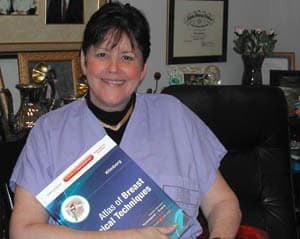Breast Cancer Study Finds Alternative to Radiation Therapy
July 24, 2012 | A breast cancer study led by surgeon V. Suzanne Klimberg, M.D., at the University of Arkansas for Medical Sciences (UAMS) has shown to offer an effective alternative to external radiation therapy following surgery. “Radiation has a range of difficult side effects, including shrinkage of breast tissue, loss of sensation and damage to nearby healthy tissue,” said Klimberg, professor of surgery and pathology in the UAMS College of Medicine, and president of the American Society of Breast Surgeons “Additionally, for patients in rural areas in the United States and around the world, external radiation therapy — the standard of care following lumpectomy surgery — simply isn’t an option if a therapy center is not located nearby. Today, these patients have no choice but mastectomy.” Results of the long-term study were reported at the American Society of Breast Surgeons Annual Meeting in Phoenix in May by Klimberg, who holds the Muriel Balsam Chair in Surgical Oncology at UAMS. Klimberg reported that utilizing radiofrequency-generated heat to create an added disease-free zone around the tumor cavity during surgery is at least as effective in preventing local tumor recurrence as radiation following surgery. In many cases, ablation also extended the disease-free zone sufficiently to eliminate the need for repeat surgery. Klimberg also serves as director of the Breast Cancer Program at the UAMS Winthrop P. Rockefeller Cancer Institute. In the study, 60 patients with invasive cancer underwent lumpectomy surgery followed by the insertion of a radiofrequency ablation (RFA) probe that is heated to 100 degrees C for 15 minutes, creating a one centimeter zone of dead tissue around the cavity. The procedure is intended to give the patient a cancer-free area around the site where the tumor was removed so that a second surgery in the area is unnecessary. None of the patients received additional radiation. Patients in the study were followed with a mammogram and physical exam every six months for the first two years and yearly thereafter. During the nine-year study, patients have been followed for an average of 44 months post-op. Pathology reports following surgery found that tumor margins were cancer-free in 44 of the patients. Fourteen of 16 remaining patients who would have returned to the operating room with similar margin findings and radiation were spared additional surgery. Only one patient recurred with a cancer nearby the original tumor site. One patient developed a cancer at a distant location. “The recurrence rate for lumpectomy with follow-up radiation is 1 percent per year for the first five years and then about one-half percent annually thereafter,” said Misti H. Wilson, M.D., breast fellow and instructor in the Department of Surgery at UAMS, another study author. “Patients in this study did extremely well. Without the side effects of radiation, radiofrequency ablation is an extremely appealing choice. The ablated tissue remains in the breast, so less breast mass is lost than with radiation, and post-treatment tissue shrinkage is not a problem. The cosmetic results are excellent. Often, you can barely tell a patient has had surgery.” Klimberg also noted that the radiofrequency ablation has a range of practical advantages compared to radiation therapy. It is delivered by the breast surgeon and does not require extensive special training. Unlike radiation, it can be delivered in any operating room with no equipment other than a probe and does not require follow-up treatment. RFA has been successfully used for many years to treat a range of other types of cancer by destroying the entire tumor. But its application in breast cancer has been difficult due to the characteristics of breast tissue. Only recently have surgeons begun exploring it as an alternative to radiation to extend the margins of the tumor bed. Based on the results of this study, radio frequency ablation is now being examined in a multicenter ABLATE (Radiofrequency Ablation after Breast Lumpectomy Added to Extend Intraoperative Margins) trial. To date, the trial includes five centers (UAMS Winthrop P. Rockefeller Cancer Institute, Columbia University, University of Kansas, Comprehensive Breast Care of San Diego and University of Arizona) and is actively recruiting and training additional sites. |
